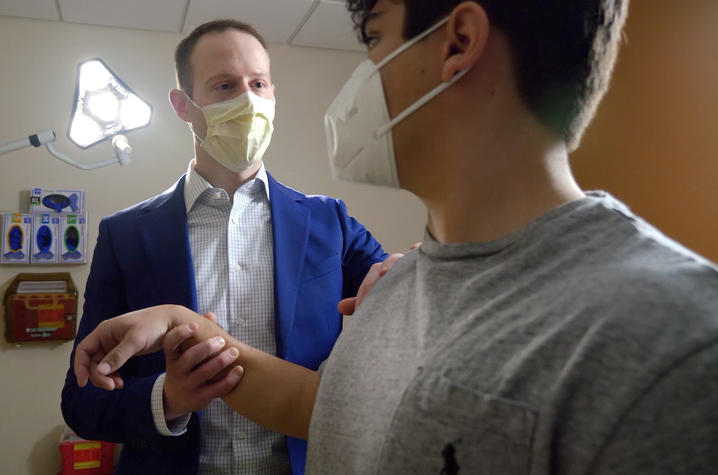UK orthopaedic surgeon receives grant to study knee injuries, osteoarthritis
Video produced by UK Research Communications and UK HealthCare Brand Strategy. To view captions for this video, push play and click on the CC icon in the bottom right hand corner of the screen. If using a mobile device, click on the "thought bubble" in the same area.
LEXINGTON, Ky. (Nov. 16. 2022) — From patient to physician, one University of Kentucky researcher is focused on helping Kentuckians gain a better quality of life after injuries to their joints.
Austin Stone, M.D., Ph.D., an assistant professor of orthopaedic surgery and sports medicine in the College of Medicine, was recently awarded a $250,000 grant from the American Orthopaedic Society for Sports Medicine for a two-year study on posttraumatic osteoarthritis in knees and therapies for prevention.
Stone is the principal investigator on the grant that includes co-investigators Caitlin Conley, Ph.D., an assistant professor of orthopaedic surgery and sports medicine, Michael Samaan, Ph.D., an assistant professor of kinesiology and health promotion in the College of Education, and Katherine Thompson, Ph.D., an associate professor of statistics in the College of Arts and Sciences.
Osteoarthritis is the most common form of arthritis. With it, the cartilage that provides a cushion in the knees begins to break down causing the joints to gradually deteriorate and can ultimately lead to full knee replacements. Stone, also a surgeon with UK Orthopaedic Surgery & Sports Medicine, is studying how that process can accelerate after injury.
Most knee injuries are problems with the meniscus, either tears or a cartilage issue, or a tear in the anterior cruciate ligament (ACL). Meniscus injury increases the risk of posttraumatic osteoarthritis. Arthroscopic meniscus procedures are the most common orthopaedic procedure in the U.S. affecting 15% of Americans ages 10 to 65. According to the Centers for Disease Control and Prevention, ACL injury affects roughly 250,000 people yearly, with annual health care costs exceeding $2 billion.
“This leads to downstream problems that are extremely prevalent in the U.S., like posttraumatic osteoarthritis that we’re learning is a consequence of these earlier injuries,” Stone said. “The focus of my research is on the prevention of this and identifying disease-modifying therapies so that once you sustain an injury, you limit the chance of getting arthritis later in life.”
Stone is working toward a comprehensive understanding of the disease process and how cartilage and other joint tissues respond to injury. He’s studying several factors in the progression of arthritis. He believes an inflammatory process starts after a knee injury that makes enzymes and cell activity that degrades the joint structures over time.
“Most people who sustain these injuries many times have surgery, they get better, and they don’t know that this process is going on. We call it a silent killer. That’s what leads to the development of posttraumatic osteoarthritis,” said Stone. “We are very much naive in understanding the mechanisms of posttraumatic osteoarthritis in both the knee, the hip and the shoulder.”
There is no cure for osteoarthritis, but there are ways to ease pain and fight stiffness in joints. Patients can take pain and anti-inflammatory medications and surgery can improve pain and function. Physical therapy and strengthening are key parts of any treatment plan.
“Physical therapy is extraordinarily important after surgery because this is where you teach the muscles to be a muscle and to respond appropriately. It’s critical for a successful surgical outcome,” said Stone. “Physical therapy also has a massive role in nonsurgical treatment. Many patients developing knee or shoulder pain can be very effectively treated with proper physical therapy to restore what the body should be doing but is not due to some pain or inciting injury.”
Stone’s research also concentrates on understanding which portions of physical therapy help patients with their performance and return them to everyday life.
“I think that one of the most rewarding aspects of the research is when you start to put together fundamental processes that you can translate to clinical applicability and being able to make a tangible difference,” Stone said.
In the knee, Stone is observing a specific cell state called senescence, where damaged cells don’t die off when they should. Instead, they continue to release chemicals that can trigger inflammation, like how one moldy piece of fruit can infect the whole bowl. Cellular senescence is connected to osteoarthritis. Stone is researching how cell activity changes after injury and surgery, how it contributes to changes in cartilage composition and its impact on patients in the year following injury.
Stone also does clinical research on upper extremity injuries in throwing athletes. He credits UK’s wide network of researchers and collaborations for a fluid transition between translational and clinical research programs that ultimately benefit patients and better the educational opportunities at the university.
“The importance of the research enterprise is collaboration, and we have a wide breadth of collaborative efforts here at UK. Within orthopaedics, we collaborate with basic scientists and with physical therapists, athletic training education programs and radiology training programs. It has a wide footprint. I think that that’s a huge opportunity. I would say that we’ve even expanded our research efforts into better relationships with psychology research and sleep behavior as well as obesity and other general health concerns. I think that’s a unique opportunity here, and there’s a wide range of engagement,” said Stone.
Stone also teaches the next generation of orthopaedic surgeons in the UK College of Medicine. He says his work in research has helped in encouraging trainees to think outside of the box.
“But to think outside of the box, I think you have to understand what’s in the box,” Stone explained. “I really drive my trainees to understand the literature that’s out there and to apply the evidence-based approach to their practice of medicine and then to start thinking of more innovative ways to expand that knowledge base.”
Stone entered the field of orthopaedics because of experience with his own injuries. “Sports medicine had always spoken to me because I really believe in restoring the quality of life and heavily in the desire to return to activity,” he said.
“I earned my doctorate doing very basic cell-type experiments, and while this laid the foundation for what I’m doing now, I think that the translation of that research is far more rewarding for me. I’m a surgeon at heart, and I really like to see people get better after their operations,” said Stone. “This study provides me an avenue to help be at the forefront of those developments and really participate in the patient’s care at a very basic level.”
The project described was supported by a grant from the American Orthopaedic Society for Sports Medicine. The content is solely the responsibility of the authors and does not necessarily represent the official views of the American Orthopaedic Society for Sports Medicine.


As the state’s flagship, land-grant institution, the University of Kentucky exists to advance the Commonwealth. We do that by preparing the next generation of leaders — placing students at the heart of everything we do — and transforming the lives of Kentuckians through education, research and creative work, service and health care. We pride ourselves on being a catalyst for breakthroughs and a force for healing, a place where ingenuity unfolds. It's all made possible by our people — visionaries, disruptors and pioneers — who make up 200 academic programs, a $476.5 million research and development enterprise and a world-class medical center, all on one campus.




